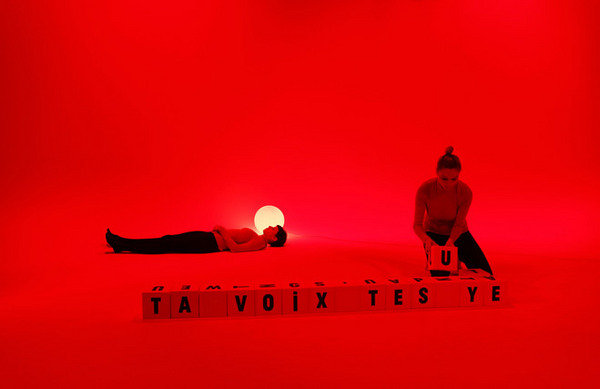Boris Achour
dal 12/4/2012 al 2/6/2012
Segnalato da
Le Credac Centre d'art contemporain
12/4/2012
Boris Achour
le Credac Centre d'art contemporain, Ivry-sur-Seine
Seances. A project that evokes both the art exhibition and pure spectacle, and in which different artistic disciplines and fields of knowledge are mixed in an uninterrupted space.

Crédac and La Triennale have joined forces to present Boris Achour’s Séances (Sessions), a project that evokes both the art exhibition and pure spectacle, and in which different artistic disciplines and fields of knowledge are mixed in an uninterrupted space. The concept of Intense Proximity, which was formulated by Okwui Enwezor, the curator of La Triennale 2012, merges with the concerns of the Contemporary Art Center of Ivry — Crédac on several levels: first, in the connections the center and the periphery normally maintain; secondly, in the fact that it questions how an art center situates itself vis-à-vis local cultural issues within the perspective of a global world; and finally and most importantly, in the forging of a connection of “intense proximity” between artists and the different audiences for the art of today.
Séances is a new addition to the Conatus series that Achour began back in 2006. Plunged in partial darkness, a range of elements form a setting/ landscape that visitors are meant to wander around for forty-five minutes. Films, sculptures, texts, sounds… yet not a single actor or live event: the combination of formal elements, a venue, a timeframe and an audience makes this art piece more akin to a show or spectacle. No one particular way of visiting the project is singled out; the films and events unfold at the same time and without any chronological order, generating a nonlinear, branching form of narrative. It is up to the viewer to construct their own story through methods of mental association, collage or correlation (forms, ideas, sensations) that suggest film editing, the police procedural or psychoanalysis. Even if the viewer is never a simple, passive receiver but always participates actively in making sense of a work of art, with Séances it is a matter of exemplifying that active part and placing the artist’s own involvement in the artwork and the viewer’s on the very same level of necessity. This non-authoritarian dimension recalls one of the concerns at the heart of La Triennale and its concept of Intense Proximité, i.e., the wish to offer writings and tales from history (and here, simply a story) that break down any and all monolithic, unequivocal or dominant constructions.
Thus, Séances invites us to the construction of a narrative and therefore a space that is both physical and mental, made possible by the articulation of dissimilar images and objects for which we do not know whether they share a common origin or not. Ritual and gestural assemblies, camp fires, segments of poems and so on form a scattered whole that presents multiple echoes and unspecified functions. The films and sculptures become sources of light, while pieces of sculpture also figure in certain films as accessories, suggesting a fluidity of or porousness between artistic media and their uses.
The many collaborations with dancers, musicians, graphic designers, theoreticians and writers that Séances has generated are also part of the movement to expand and open up the project to other, different forms, practices and sensibilities. Of these the Bibliothèque des Fragments (Library of Fragments) stands apart. The Bibliothèque brings together an open collection of texts written for the project by several authors, including Jean-Yves Jouannais, Eric Mangion, Gaëlle Obiégly, Nathalie Quintane, Michele Robecchi, Guillaume Désanges, who were invited to devise their own narrative within Séances. From science fiction to the compilation of historic texts to the theoretical essay, this library, still under construction, is a concert of different voices that both share in the plurality of experience at work in the project and enrich how we perceive it. Origin and archive at one and the same time, this collection of texts maintains the ambiguity of a pre- existing story, albeit one whose meaning still has to be constructed.
Thus, in words and a range of spaces, the notion of obscurity is everywhere and suggests a past time or an apocalyptic future, a world in which night is without end. Unless, that is, as in any good science- fiction novel, it is in fact all about our present:
« There existed once a blue sky, you certainly must have seen it in a photo, film or painting. Which of them best offers you the feeling of the clear sky, of what it’s like to live beneath the ligh- ted sky? What for you will have best betokened the former world, the time when we were in the light of the sky and were nevertheless not happy all of us, always, and at the same time? And so I come to what I wanted to tell you. That catastro- phe you may have already heard about. Which plunged the world into darkness. Which forces you to keep the lamps lit at all times. We learned afterwards what had happened. I was still quite young. It’s what makes it possible for me to bear witness. »
Centre d'art contemporain d'Ivry - le Crédac
La Manufacture des Œillets
25-29 rue Raspail - Ivry-sur-Seine
Open every day (except Mondays) 2–6 PM, weekends 2–7 PM
Free admission



